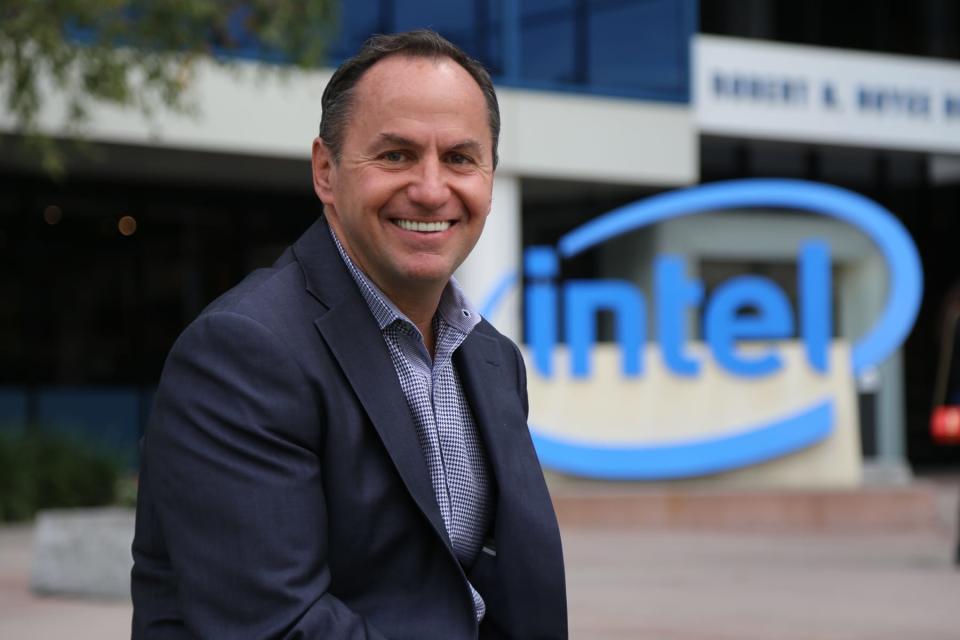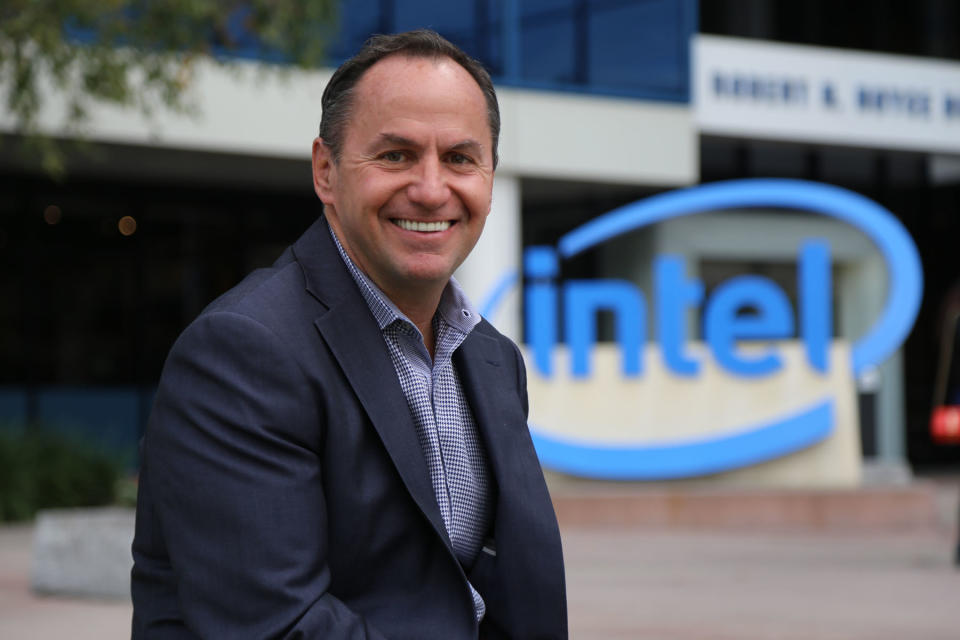Intel's new CEO is facing the same old challenges
Manufacturing, innovation and the threat of a global recession, the usual stuff.
After seven months as interim CEO, Robert "Bob" Holmes Swan has been appointed as Intel's seventh full-time leader. Swan started life at General Electric, spending 15 years there before leaving to become vice president (and later CEO) of the doomed online grocery business Webvan. In 2006, he returned to the technology industry as eBay's CFO, a position he held for nearly a decade. In 2016, he joined Intel as CFO, one of a handful of "outside hires" the notoriously inward-looking company placed in leadership roles. And he takes the helm at a crucial time for the chipmaker as it looks to revitalize itself in a world that may no longer need the technologies the giant offers.
Manufacturing
For a company that lives and dies on its manufacturing, Intel's recent record isn't great. Cannon Lake is the codename for its first 10-nanometer chip, which was expected to arrive in 2016. Unfortunately, the company struggled to get the yields -- the number of functional, saleable chips -- high enough.
After numerous delays, the company began shipping a "10nm chip" of sorts, in low numbers, but only really for appearance's sake. The silicon was apparently so compromised that the integrated graphics had to be disabled, and the chips were sold inside a China-only Lenovo Ideapad 330.
Mass-production on the sort of scale that Intel, and we, expect has yet to happen, and the company is apparently redesigning the chips from the ground up. But the delay has allowed rivals, like Samsung and TSMC, to boast about its own 7nm and, in Samsung's case, 8nm silicon. Those chips are not the same as one of Intel's desktop CPUs (marketing spin is strong), but the fact remains that Intel has slipped here.
Production hell has had a knock-on effect for the rest of Intel's production lines, which weren't prepared for a surge in PC buying across 2018. Those looking for a low-cost laptop struggled as Intel chopped and changed its strategy to cope with demand.
In September, Swan had to write an open letter explaining the situation. The company decided to prioritize "the production of Intel Xeon and Intel Core processors," he wrote, so it could "serve the high-performance segments of the market." In short, Intel would focus on building and selling its most expensive chips while supplies were short.
Swan's appointment letter outlined four priorities under his leadership, and the terseness of this third point spoke volumes. "Third, our execution must improve. And it will. Our customers are counting on us," he wrote, suggesting he doesn't want to have to write another public apology any time soon.
The PC business
Intel can point to its blockbuster 2018 as a sign that everything's okay -- the company made a $21.1 billion profit over the year -- but the PC market is still in a serious decline. On the upside, Gartner says that Intel's failure to make enough new chips means there's likely a big market for new PCs in 2019. But with a global recession looming, people are likely to avoid spending on pricey new tech if they can avoid it. Which would mean that Intel could see demand slump for its chips just as it's ready to serve all of the pent-up demand.
Intel is hoping to balance out any fall in consumer spending by pushing towards its data center business, but that's also in jeopardy. The company announced that unit volumes fell by three percent at the end of 2018, pointing to a slowdown in spending. It's likely that, between a recession, a trade war and the potential that there's little growth in the data center market, Intel may find itself boxed in. In its 2019 forecast, the company said that reduced demand from China, as well as the big cloud players, may see its figures drop in the near future.
Moore's Law and the competition
Swan's going to have to deal with the technical limits that Intel is struggling to push past in order to keep making faster, better chips. The death of Moore's Law means that the company will need to find innovative new solutions to not lose ground and, crucially, miss deadlines.
The magic bullet for Intel's woes may be in the form of Extreme Ultraviolet Lithography (EUV), a way to make chips at far greater density. Essentially, if current chipmaking methods are akin to writing with a fat sharpie, EUV is a wafer-thin ballpoint.
In October 2018, Samsung announced that it was ready to start building 7nm chips using the process, and will ramp up next year. And, potentially, densities could get higher in the not-too-distant future. Intel, meanwhile, reportedly won't even start using EUV in its factories until 2021 at the earliest.
In the PC space, AMD has been able to at least become competitive with Intel's desktop chips, and offers very good price to performance ratio. It's still a distant second, but compare benchmarks and you'll spot several AMD chips that are far cheaper than their closest Intel equivalents.
Intel will also be nursing a grudge about how it let the world of mobile slip through its fingers, allowing ARM licensees to dominate. These low-power chips are less capable than Intel's laptop offerings, but innovation in the space has skyrocketed in the last decade. Look at what Apple has been able to do with its A-Series chips, and you can see why Intel might be mildly concerned.
Right now, the chips that ARM licensees like Qualcomm and Apple create are not suited for full-power desktop (or laptop) computing. But Apple's A-series chips are the equal to Intel's laptop chips in benchmarks at the very least. And plenty of companies, led by Microsoft, are testing to see if a smartphone chip could be repurposed to run inside a laptop. Look at ASUS' NovaGo, a Windows 10 laptop running a Qualcomm Snapdragon 835.
These devices are pretty lackluster right now, but if the computing industry wanted to punish Intel for its slow progress, it could. Not to mention that any performance losses could be equally balanced with far longer battery life and the promise of greater mobile connectivity. It seems there's a higher chance that an ARM chip will offer PC-like computing than there is of Intel making an all-conquering mobile chip.
Bob Swan's own record
It isn't fair to suggest that, because someone's trained in finance rather than engineering, that they're not going to be able to run a manufacturing company. But that will be a stick that the press, and analysts, will use to beat Swan if he doesn't show improvement.
He is, after all, the first Intel CEO who wasn't a "lifer" at the company and one with a background in finance. Reporting on his appointment, Bloomberg pointed out that he's only the second Intel CEO who wasn't an engineer with the company, after the late Paul Otellini. Depending on who you ask, Otellini was either a great leader who managed to nearly double Intel's profits, or the person who missed out on building the iPhone's CPU. The implication will always be that, because he's a numbers guy, he won't have the smarts to see where the industry is going. Swan will need to surround himself with people who can give him the advice that he needs.
The upsides
Thankfully, Swan's new old job shouldn't be greeted with a non-stop deluge of doom and gloom, because there are plenty of reasons for optimism. Like the fact that Intel really is the only game in town for most corporate buyers, and still benefits from the Wintel lock-in. The existential threats to its future have been known for a while, and the core business, as it stands, remains healthy for now.
On January 24th, Intel announced its fourth-quarter and full-year figures for 2018, and they make for extraordinary reading. The company pulled in revenues of $18.7 billion and $70.8 billion, respectively, making a net profit of $21.1 billion across the year. And, for as long as Swan can avoid the company throwing buckets of cash out the window, it's likely he'll have the time to implement his plan.
In his letter, Swan said that Intel's "core strategy is not changing," which is fine, so long as he's capable of doing what his predecessor couldn't: making that strategy work. Good luck, Bob.


